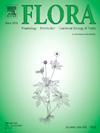奇瓦瓦沙漠具代表性的石膏属被子植物系叶片形态解剖多样性
IF 1.8
4区 生物学
Q3 ECOLOGY
引用次数: 0
摘要
生活在高石膏土壤中的石膏植物会影响水分的有效性和生理过程,它们表现出一系列的叶面策略来处理过量的钙和硫,包括旱生、多肉、大量钙、硫、镁和石膏的积累,以及钙分泌腺。由于奇瓦瓦沙漠和东方马德雷山脉周边地区的石膏土壤中物种丰富,对哪些物种的叶片解剖知识很少,本文的目的是确定覆盖代表性被子植物谱系的各属石膏物种的形态和解剖多样性,并将其与周边地区这些属的石膏或疏石膏物种的多样性进行比较。对14目21科29属48种的田间固定叶片的横截面和正截面进行了研究。我们在分类类群和gypsophytes, gypsovags和gypsophobes之间建立了41个字符的比较表。结果表明,所研究属间形态解剖差异显著,三组间无统计学差异。观察到的旱胚特征——即增厚的角质层和外周壁、凹陷的气孔、毛状体的存在、发育良好的栅栏组织和鞘的延伸——与在营养贫乏的土壤中生存的物种一致,这些土壤具有低水分可用性和高入射光水平,这些植物生活在干旱地区的特征。最初的发现,如检测较少报道的特征(例如,血管呈放射状排列,胶质纤维)和首次研究的许多物种的叶片解剖结构,有助于解剖学知识。本文章由计算机程序翻译,如有差异,请以英文原文为准。
Leaf morphoanatomical diversity of representative gypsophyte angiosperm lineages from the Chihuahuan Desert
The gypsophytes living in soils high in gypsum, which affects water availability and physiological processes, exhibit a range of foliar strategies to deal with excess Ca and S. These include xeromorphy, succulence, accumulation of large amounts of Ca, S, Mg, and gypsum, as well as calcium-secreting glands. Due to the great richness of species in the gypsum soils of the Chihuahuan Desert and the surrounding areas of the Sierra Madre Oriental, as to which species there is little knowledge of leaf anatomy, the aim of this contribution was to determine the morphological and anatomical diversity of gypsophyte species of various genera covering representative angiosperm lineages and compare this diversity with that of gypsovag or gypsophobe species of those genera from the surrounding areas. The study was conducted in cross-sections and paradermal sections of field-fixed leaves from 48 species of 29 genera belonging to 21 families within 14 orders. We generated comparative tables based on 41 characters among taxonomic groups and among gypsophytes, gypsovags, and gypsophobes. The results show remarkable morphoanatomical diversity among the studied genera and the three groups without statistical differences. The observed xeromorphic characteristics—namely, thickened cuticles and outer periclinal walls, sunken stomata, the presence of trichomes, well-developed palisade tissue, and sheath extensions—are consistent with those reported in species that inhabit nutrient-poor soils with low water availability and high levels of incident light, characteristics of the arid region in which these plants live. Original findings such as the detection of less-reported traits (e.g., vessels arranged in radial rows, gelatinous fibers) and the leaf anatomy for many species studied for the first time, contribute to anatomical knowledge.
求助全文
通过发布文献求助,成功后即可免费获取论文全文。
去求助
来源期刊

Flora
生物-植物科学
CiteScore
3.30
自引率
10.50%
发文量
130
审稿时长
54 days
期刊介绍:
FLORA publishes original contributions and review articles on plant structure (morphology and anatomy), plant distribution (incl. phylogeography) and plant functional ecology (ecophysiology, population ecology and population genetics, organismic interactions, community ecology, ecosystem ecology). Manuscripts (both original and review articles) on a single topic can be compiled in Special Issues, for which suggestions are welcome.
FLORA, the scientific botanical journal with the longest uninterrupted publication sequence (since 1818), considers manuscripts in the above areas which appeal a broad scientific and international readership. Manuscripts focused on floristics and vegetation science will only be considered if they exceed the pure descriptive approach and have relevance for interpreting plant morphology, distribution or ecology. Manuscripts whose content is restricted to purely systematic and nomenclature matters, to geobotanical aspects of only local interest, to pure applications in agri-, horti- or silviculture and pharmacology, and experimental studies dealing exclusively with investigations at the cellular and subcellular level will not be accepted. Manuscripts dealing with comparative and evolutionary aspects of morphology, anatomy and development are welcome.
 求助内容:
求助内容: 应助结果提醒方式:
应助结果提醒方式:


